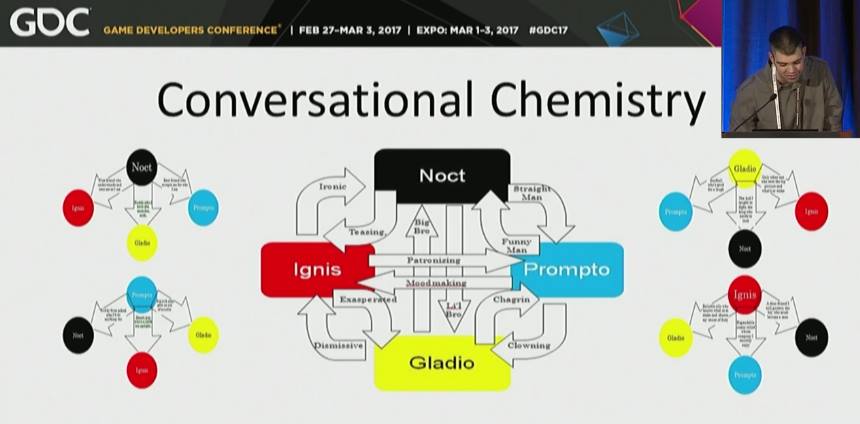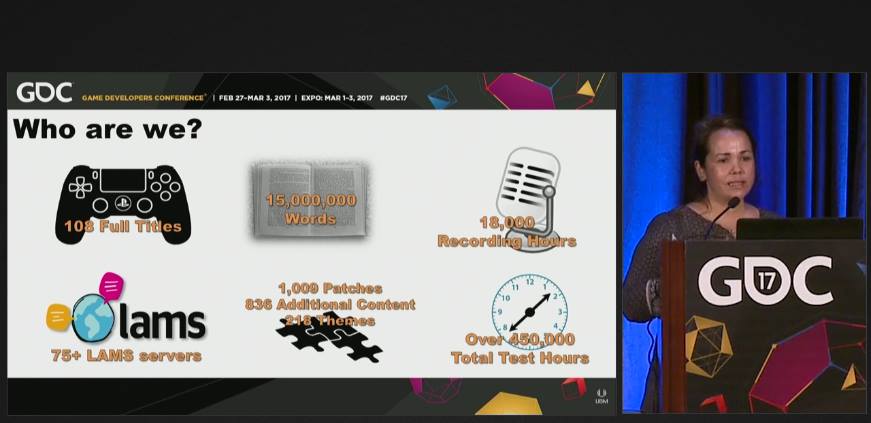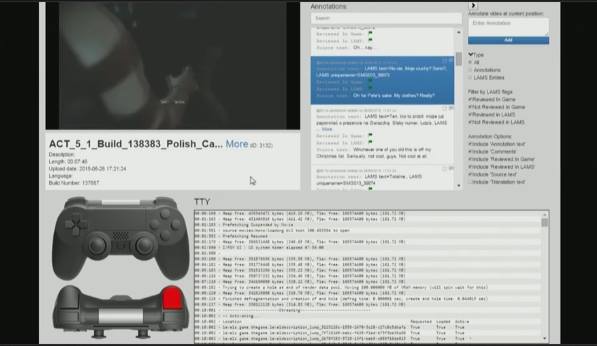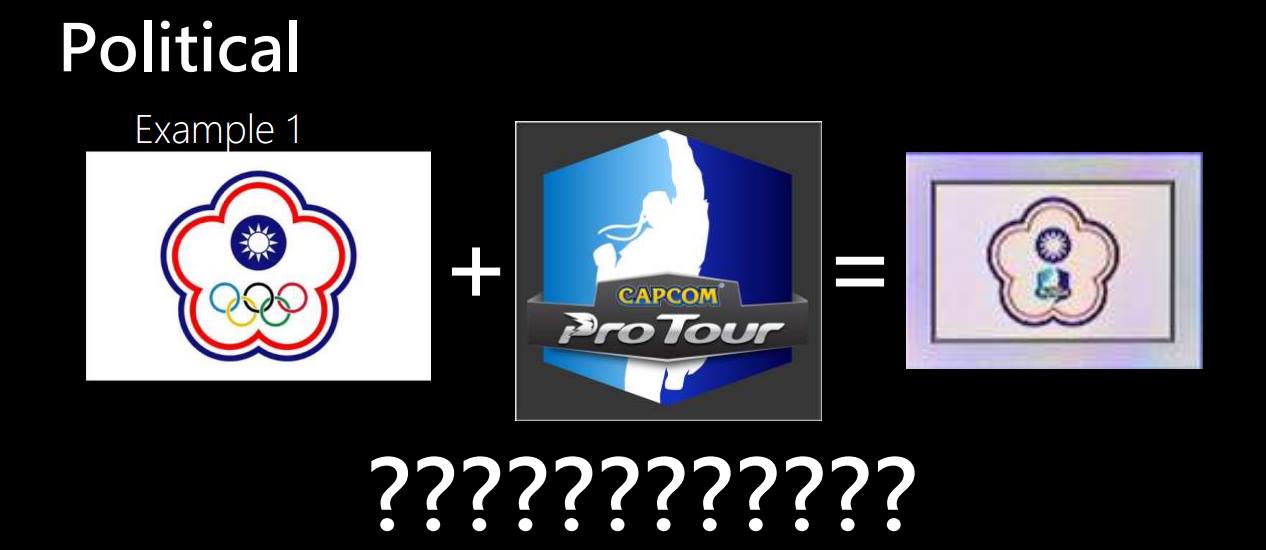For a quick summary of the localization round table, see here
“Bringing Fantasy to Life in 'Final Fantasy XV” - Dan Inoue (Square Enix)
Final Fantasy XV was created based on reality, and how localization played into that.

A real world setting with touches of High Fantasy
Each FF title is different from the others and they all pick and mix world mythologies to build their own lore. Final Fantasy XV’s angle was to be a “Fantasy based on reality”
The film and the anime weren’t thinly-related spin-offs or throwaway side-stories, but “threaded, simultaneous narratives woven together across media”(designed to be integrated but independent narratives)
Final Fantasy XV has been released worldwide in twelve languages simultaneously, meaning that it didn’t enjoy the usual gap between Japanese and Western release where most of the rewriting is usually carried: it had to be “global” from Day One.
Like previous FF titles borrowedfrom world mythologies, FF XV borrowed whole world locations for its four civilizations (including architecture, lifestyle and language), with Altissia inspired by Venice,Lucis continent mixing English, French and Gaelic, and so on.
While fantasy games often use illegible text to save time and effort, FF XV used its local teams as advisers, picking French inspired names with the French, Italian inspired ones with the Italians and so on, giving depth and realism to this road trip story (and avoiding comical mistakes).
The Insomnia capital is different in that it was designed as a melting pot, constantly mixing bits ofLondon, New York, Paris and Tokyo.
Another new solution they devised was to use accents based on social circles more than geographic origin, giving the idea of a more globalized world (and opening the door to a more diverse casting)
And yes, product placement was a bit jarring sometimes, but they tried to handle it in a respectful and sometimes ironic way
“Who wouldn’t want to take a road trip with James Bond, Ferris Bueller and John McClane?”
The main cast was based on well known archetypes: Ignis is James Bond, Prompto is Ferris Bueller and Gladio is John McClane from Die Hard, all fantasy characters except Notcis who is Kurt Cobain (but using a real person in this case really worked well, so they ignored this “rule”). Incidentally this was an idea from the voice actor: it’s always worth hearing what they say, since they often understand the characters very well.
Of course they tinkered with these archetypes, but they gave a compass for really bringing the characters to the the audience, which isn’t always easy when crossing languages, cultures, medias and writers.

Since you spend much time traveling and chatting with these characters, it was important for their conversations to feel real. Thiswas achieved by defining their usual type of interaction (Irony VS teasing, Big bro VS Lil Bro), adding nicknames and idiosyncrasies like “generally avoids contractions” or “never says he’s sorry” and so on (again, very helpful in bringing these characters across media and writers)
This focus on character dynamic was very helpful to give cohesion in a game so eclectic that you get high fantasy characters talking to Kurt Cobain pretty much from the start.
Also, they aimed for a natural feel in the conversation, with short sentences, mumbling (which also helped with matching the Japanese timing), and generally having lines refer to each other in order to get a more organic feeling.
On the other side of the spectrum, dialogs from the gods were designed in order to always avoid the words “you” or “I” creating an otherworldly sense of detachment. (This was created for one specific goddess and worked very well, so it was expanded to all the gods, to make them feel detached from humanity.)
In order to keep the lore both accessible and intriguing, common terms likeGods, Demons, Messengers and Oracles were used, siding them with richer synonyms like “Archaeon” or “Land Forger” where the tone or personality of a character required it
Problems
Although dialogs were designed around a branching path structure from the outset, the developers went even further, reusing audio cues across conversations.
This was problematic in terms of grammar, but especially negative for the intonations, leading to a robotic feel, so descriptors were added to the lines (singular/plural, beginning of sentence/part of conversation) in order to help the AI minimize the issue.
The finalized game mixed fully scripted conversations with others concatenated through this system and was well received in this department.
It’s pretty much impossible to control the flow of information in a project that needs to be launched and promoted on three different media. This inevitably means that there were spoilers, but it’s not really a big issue.
Unless you base your story on a big twist, what really means is the build up of the plot, not theMcGuffin it revolves around (if you’re relying on the big twists in 2017, it’s not a good idea)
"Steps for Effective Localization" - Nadège Josa (Sony Interactive Entertainment Europe)
The sooner you get in touch with your localization partners, both at management, code and text level, the better.
The first decision will be the type of pipeline to follow.
A linear “waterfall” process is best suited to cases were the full game has been created. Get in touch during the alpha of the game, share final script and audio assets, localize, implement, test and done.
However, larger and more complex projects can be dealt with more efficiently with an iterative model where translation, recording and testing are split into repeated loops.
Localization Asset Management System
In order to handle this process efficiently, Sony Interactive has created LAMS, a centralized server that allows to coordinate work across all the stakeholders (developers, localizers and testers) and acts as a repository for text, audio and subtitles for all titles.
The goal of this presentation was to share its features as a blueprint of sorts that other can follow.
It’s a flexible platform that allows to interface SIE’s internal systems with the tools already used by the developers. The provided API makes integration simple and opens many other possibilities.
Localization is a massive collaborative effort, and thus access is key. Allowing remote access, supporting multiple file formats and enforcing strict version control are all key features of LAMS.
Communication is also key, and thus everyone involved around the globe must be kept informed and on the same page. That’s why LAMS allows to save and share specific searches, so that (for example) a developer can ask their US and Japan localization teams to work on different strings - without having to send a long detailed email for it, “what you see is what you work on”

Context is a big problem for localization: without direct access to the game, even being sure what a common term like “fire” really refers to can be pretty hard. That’s why LAMS allows asking and sharing such questions directly into the text localizers are working on, an integrated Question and Answer system with pictures that both translators and testers can refer to.
One of the reasons for starting the localization process early is defining limits. Once specifications like the maximum length of text or the sample rate of audio are defined, a tool like LAMS can check them automatically and warn about issues the very moment they get updated, saving a substantial amount of time.
A system like this can also automate other tasks, for example segmenting the text into subtitles based on the waveform of the audio - a technique that allowed to prepare 93% of the subtitles for Until Dawn without human intervention (saving time and money).
LAMS also automated reporting: any search created or shared can be turned into a recurring report, automatically mailed to you with the desired graphs and visualizations.
As mentioned before, LAMS has an API that allows to interface with external tools. One of the most interesting is the streaming tool that allows translators and testers to search any string (by ID or words) and see it directly in the game, through a streamed video capture that includes all LAMS annotations and the controls being used in that moment.

In the future
In the future LAMS could be expanded to verify Naming Conventions, spotting typos, forbidden terms and missing lines right away
The system will also be expanded to allow the creation of variants for any strings, so that VR games (for example) can display masculine and feminine versions of their player prompts for all languages that need it
Translators should also be able to use the system in order to systematically verify their own translations in-game, improving quality and immersionAlso the audio mastering could be centralized, standardizing the volume of assets in dialogs
"Meet your Localization experts early, invest in a tool (any tool), empower your Localization experts, automate & validate your Localization testing"
Localization Shenanigans in the Chinese Speaking World - Jung-Sheng Lin (IGDShare)
Quality of localization into Chinese has been lacking in the past, leading to comical mistakes, but with the growing financial importance of the Chinese market, things are changing quickly
Taiwan is an interesting option for people interested in the Chinese market: it’s reasonably sized (on par with Germany and Australia on the iOs/Google Play charts) and can be used as a soft-launch base
One of the first challenges is the difference between Simplified Chinese writing (used in the People's Republic of China and Singapore) and Traditional writing (used in Taiwan, Hong Kong and Macau)
Alas the conversion is not one to one, so you really need a professional to parse the text and avoid pitfalls like converting software menu with 菜單 the traditional character for restaurant menu instead
Even games without text face an important challenge: picking a Chinese title. All developers should partner with their translators and pick a good name as soon as possible, for two reasons
Stopping the spread of unofficial names
Braid launched as is, without a translated title and ended up being named by the press as 时空幻境 (Time and space fantasy) which is problematic since it’s the official name for “Tales of Phantasia” - hindering discoverability
This phenomenon snowballed when Netflix subtitled “Indie game the movie” using Wikipedia as reference. This meant that all games are named with their unofficial (and often wrong) title, making that all traction from the movie is lost since players cannot find them and buy them online by that name
Meeting Chinese regulations
Since late 2006 there’s a policy requiring zero foreign text to be present into games that wish to receive approval (a process that can take up to six months)
That means that you might get a list of pre-approved titles from your publisher. For example, that’s how Thumper got named暴走甲虫 (Rampaging Beetle) with little say from the author
(Sometimes the Chinese commission goes to the point of asking even singer names in the soundtrack to be translated, but at least on that point they could be reasoned with)
Long story short: you really need a local publisher that can deal with the back and forth with the regulators. Sometimes it’s reasonable, sometimes it’s less, but it is a long process
Misc. recommendations: stick to UTF-8, get ready to resize text to keep it readable, get ready to pay up to $10,000 for good fonts or be prepared for system font blandness, specify which Chinese your language is (traditional or simplified?)
Notable free, embeddable fonts for Chinese: Serif – Hanazono Mincho (花園明朝) Sans – Google Noto Sans CJK & WenQuanYi
Political issues
The Chinese-speaking region has quite a few nationalist tensions that can impact directly games published there
Recently there was a bit of tension about Pokémon, since Sun and Moon dropped the names used for 20 years in Hong Kong in favor of those used in China and Taiwan. On the other hand, Bandai keeps using separate names in Hong Kong, China and Taiwan for its Gundam series
Other examples include Street Fighter V using its own version of the Taiwan flag in order to avoid tensions with China, PES 2017 locking players using Taiwan out of international matches, and Sega’s Yakuza 6 being hastily re-dubbing one line from “What’s your impression of the country of Taiwan” to “What’s your impression ofTaiwan” (although the Yakuza series was never sold in the PRC)
